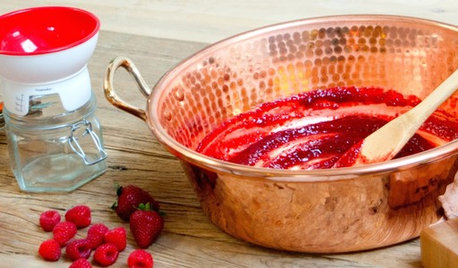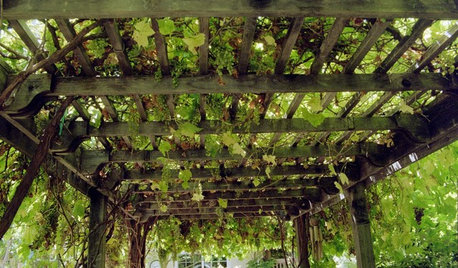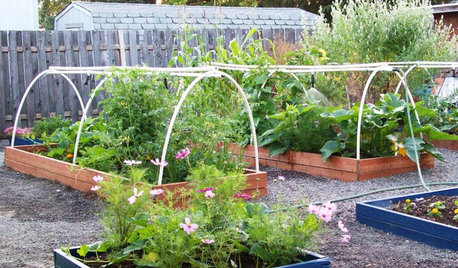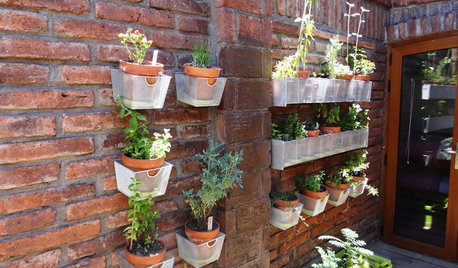My poor cherry tomatoes!
Kelsey Anderson
9 years ago
Featured Answer
Sort by:Oldest
Comments (12)
Kelsey Anderson
9 years agoRelated Discussions
My Poor Tomatos!
Comments (2)Susan, Without seeing the plants, it is hard to guess. Any part of the leaves that didn't have pine sap on them likely still would function properly, i.e. by conducting photosynthesis. I probably would have left them for the time being and just would have watched to see how the plant was performing. This is one of those where you just flip a coin and decide what to do. Eventually those leaves probably would have to come off if they were heavily covered, but if the plant was fairly small, I might have left the leaves on so they could help the plant grow and get larger, and then I would have removed them after it had more leaves to take over their function. If the plants were larger and the foliage was a small percentage of the overall foliage, then I doubt the plant will even miss those few leaves. The loss of the flower cluster is minimal. Once a plant is large enough to form flowers and fruit, it does so pretty much non-stop. This isn't a common question where we have an answer on the tip of our tongues. Your daughter has my sympathy. This pregnancy has been really tough on her. Dawn...See MoreWhat's wrong with my poor tomato seedling?? Help please!
Comments (12)Potting mix that holds too much water is like fighting a losing battle. Peat and perlite wouldn't have much in it for the plant and your kelp fertilizer by your description seems unbalanced. I think a good potting mix with some extra perlite in it might have the proper pH and a little fertility. I am no expert but I have found that drainage is critical. I think you have a combination of potting mix holding too much water and a lack of nutrients. You have a control because your plant with worm castings looks better. Do you have any more worm castings? I am thinking you could put them in water and strain it then use the 'castings' tea next time your plant is dry. I am having a problem with some of my plants and the difference is I ran out of one batch of potting mix and used another on the later plants. I treated them the same but the earliest potting mix drained well and those plants look better....See Morepictures of my poor cherry tomato plants
Comments (4)Its called blossom drop. Check the FAQ's at the top of the page or do a search at the bottom. You will find a wealth of info on it. Its normal with high or low temps ......See MoreMy Poor Diseased Tomatoe Plants
Comments (5)By "woody", do you mean the bottom of the stem went brown and hard, possibly sunken on the outside? Was the hollow inside of the stem discolored (brown or black)? Did the tops start to wilt, without spots on the leaves? With the cool weather you (presumably) still have up in most parts of Canada, the recently-fresh manure that d mentions, and the hollow stems followed by top-down symptoms, I'm looking hard at pith necrosis (Pseudomonas corrugata and friends). It's favored by cool nights and high humidity early in the season, and it really takes off in plants fed heavily with nitrogen... manure which hasn't been sufficiently composted can be kind of "hot" sometimes. Have a look at the Cornell page on pith necrosis and see whether that matches well with what you have. If not, let us know more details on your garden and what you're seeing with the plants, and we can try to pin it down from there. --Alison...See Morep_mac
9 years agooldbusy1
9 years agoOkiedawn OK Zone 7
9 years agoKelsey Anderson
9 years agoOkiedawn OK Zone 7
9 years agoKelsey Anderson
9 years agochickencoupe
9 years agoOkiedawn OK Zone 7
9 years agoKelsey Anderson
9 years agoOkiedawn OK Zone 7
9 years ago
Related Stories

EDIBLE GARDENSSummer Crops: How to Grow Tomatoes
Plant tomato seedlings in spring for one of the best tastes of summer, fresh from your backyard
Full Story
MATERIALSWoodipedia: Is It Cherry or Is It Alder?
Learn the differences between these two wood types, as well as costs, sustainability and a caution about finishing
Full Story
FARM YOUR YARDHouzz Call: Home Farmers, Show Us Your Edible Gardens
We want to see where your tomatoes, summer squashes and beautiful berries are growing this summer
Full Story
SHOP HOUZZHouzz Products: Save a Taste of Summer
Can't bear to part with the flavors of summer peaches, berries and tomatoes? Then jam on it!
Full Story
GARDENING GUIDESGardening Solutions for Heavy Clay Soils
What’s a gardener to do with soil that’s easily compacted and has poor drainage? Find out here
Full Story
GARDENING GUIDES6 Plants That Beat Butterfly Bush for the Wildlife Draw
It's invasive, a nonnative and a poor insect magnet. Check out these better alternatives to butterfly bush in the garden
Full Story
GARDENING AND LANDSCAPINGVertical Gardens Raise the Limits for Landscapes
Turn a small garden space into a towering success with an upward-bound collection of edible delights
Full Story
BENEFICIAL INSECTSAttract Pollinators for a Productive Edible Garden
You can lure bees, butterflies and birds into your yard with the right flowers and nesting spots
Full Story
EDIBLE GARDENSHouzz Call: Where Are the Craziest Places You Grow Edibles?
Basil in a bathtub, spinach stacked up a wall ... If your edibles occupy an odd spot, we’d like to know
Full Story
FARM YOUR YARDHow to Grow Vegetables in Containers
Get glorious vegetables and fruits on your patio with a pro’s guidance — including his personal recipe for potting mix
Full Story


Okiedawn OK Zone 7